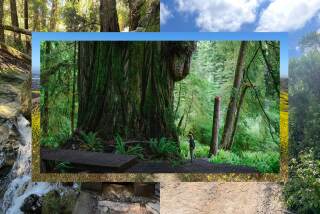Good as Gold Historic Walks
- Share via
It was here near Coloma in 1848 that James Marshall discovered gold; a year later, the world discovered California.
Marshall, a carpenter, was constructing a sawmill in partnership with John Sutter when he spotted some golden flecks in the American River.
He went to Sutter’s Fort to share his news with his employer. The two tried to keep the gold news secret, but word leaked out and the world rushed in.
The population of the hamlet of Coloma swelled to 10,000 in 1849. Two years later, the gold gave out and most of the miners left.
Today, Coloma, birthplace of the Gold Rush, is a tiny village within the boundaries of Marshall Gold Discovery State Historic Park.
Park highlights include an operating replica of Sutter’s Mill and the Gold Discovery Museum, with its mining exhibits and videos telling the story of Marshall’s discovery.
A walking tour takes in a number of 49er-era buildings, as well as structures dating from later in the 19th Century.
Step into the Wah Hop Store, a Chinese general store. Visit Marshall Cabin, where Marshall, who benefited little from his great discovery, died bitter and penniless.
Other walks into history include a stroll down Main Street Coloma and a visit to the Pioneer Cemetery and Coloma Winery.
Monument Trail climbs to James Marshall Monument, where a bigger-than-life figure holds a bigger-than-life gold nugget and points to the spot where he made his discovery.
The Monroe Ridge Trail, completed in 1993, extends 2.3 miles from North Beach picnic area to the Marshall Monument; if you want a little more of a workout than that offered by the various historical walks, this is the trail to take.
The trail honors a pioneering African American family who first settled here during the Gold Rush era.
Family matriarch Nancy Gooch was brought to California as a slave, but was freed when California entered the Union as a free state.
She made her living doing laundry and domestic chores for miners and earned enough to purchase the freedom of her son Andrew Monroe and his wife, Sara Ellen, who were still enslaved in Missouri.
The Monroes had a successful fruit orchard, prospered and began buying land.
Some of the family holdings included the famed gold discovery site, which the parks department purchased from the Monroe family in the 1940s. The Monroe Ridge Trail travels from the Marshall Monument to a vista point in the Monroe fruit orchard.
Pick up a park trail map/interpretive pamphlet, which has some fascinating historical details; the map’s east-west orientation can be confusing to hikers, however.
Directions to trail head: Marshall Gold Discovery State Historic Park is located on California 49 in Coloma, 6 1/2 miles north of Placerville on U.S. 50; about 17 miles south of Auburn and California 49’s junction with Interstate 80.
On the southern outskirts of Coloma, California 49 bends sharply east; you should bear south here onto Springs Road and in a short distance turn right on Monument Road, following it to a parking area near the Marshall Monument, which occupies the top of a hill. Walk back down the hill along the road a short way to the signed trail head on your right.
Don’t even think you’ll find a free parking place anywhere in the state park. Leave your car only in the designated areas and be prepared to pay the $5 day-use fee.
The hike: The Monroe Trail (a fire road for a short distance) leads first to an old spring house, surrounded by ferns.
You then begin a stiff half-mile northern ascent via switchbacks that bring you to Vista Point.
Rest a moment at a picnic table and admire the vista--the hamlet of Coloma and the south fork of the American River.
The path descends gently, following the ridge top, then more abruptly as it switchbacks down to the old Monroe fruit orchard.
Stop at the brass plaque honoring the Monroe family, then carefully cross California 49 to the North Beach Picnic Area.
Cross the parking lot and join the river-side path that leads to the gold discovery site and mill site, then to the sawmill replica.
Cross the highway again to the park visitor center and join the signed Monument Trail. A half-mile climb over forested slopes brings you to the top of a hill and to the James Marshall Monument, built in 1890.
The trail head is just below the monument.
Monument, Monroe Ridge Trails Where: Marshall Gold Discovery State Historic Park near Placerville. Distance: 4-mile loop. Terrain: Bank of American River, historic downtown Coloma. Highlights: Discovery site that started gold rush, James Marshall Monument. Degree of Difficulty: Easy to moderate. For More information: Marshall Gold Discovery State Historic Park, P.O. Box, 265, Coloma, Calif. 95613; tel . (916) 622-3470.
More to Read
Sign up for The Wild
We’ll help you find the best places to hike, bike and run, as well as the perfect silent spots for meditation and yoga.
You may occasionally receive promotional content from the Los Angeles Times.






